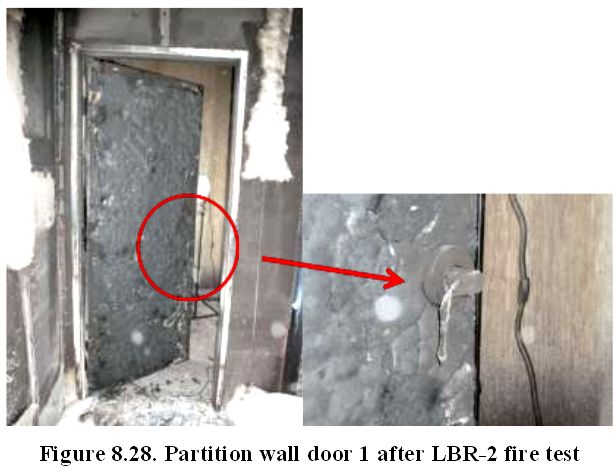While this test report was not heavy on door-related data, I thought some of you would enjoy reading about this groundbreaking study which looked at how a test building was affected by several simulated earthquakes, and then how the damaged building’s fire safety systems performed in a series of fire tests. I found the video below fascinating:
There’s more about the study at the Worcester Polytechnic Institute website and the UC San Diego site. There is a full report of the fire test program here, and a shorter executive summary here. The door-related results below are in both documents:
Some of the magnetic door holders installed on Floor 3 experienced damage during the motion tests. In one case, the magnetic bond was stronger than the fasteners used to connect the strike plate to the door, ripping the strike plate off the door. The potential fire performance concern here is that improperly operating doors might impede occupant egress and firefighter access.
Some of the doors installed on Floor 3 were not functioning properly after the motion tests. In some cases doors were not able to close completely because door frames were distorted and locks were damaged . The poten tial fire performance concern here is that smoke and fire could spread through a door, which was designed to be closed during fire, hindering occupant egress and safety . In another instance, a door on Floor 3 was jammed closed during a ground motion tests, requiring tools to be used to pry the door open. The potential fire performance concerns here are that occupants can be hindered when trying to escape, placing them at risk, and the fire service can be hindered when undertaking rescue and firefighting ope rations.
And from the full report:
9.3.3. Distorted door frame on swinging doors
Doors are intended to provide barriers to the spread of fire and smoke during fire events. Doors may be normally open or normally closed, and if normally open, may close automatically upon fire alarm. Both cases were tested.
During FB – 5 and FB – 6 , some of the door frames for swinging doors were distorted . This meant that in some cases the doors were not able to fully close (those which were held open during seismic tests) as shown in Figure 5 . 7 , and in other cases doors were jammed (those which were closed during motion tests) . This has implications for fire control, access and egress. With respect to jamming, this might be a special concern for steel doors , which if jammed tightly can be difficult to open. With respect to doors that do not close, t he openings formed by not – fully closed doors can be a path of smoke and fire spread , annulling all separation features for the compartmentation in fire conditions.
I thought this photo was interesting…as you can see the lever is completely melted and the lock is no longer usable. When people get nervous about less-bottom-rod fire exit hardware which no longer unlatches the door for egress once it has reached the melting point, I remind them that hardware is not expected to be operable after a fire. [Note: The term “LBR” used in the photo caption does not stand for “Less Bottom Rod”. It stands for “Large Burn Room.”]
Photos: Worcester Polytechnic Institute
You need to login or register to bookmark/favorite this content.






amazing video, lori – thank you
…and just goes to show you how important hardware – every little piece – really is!
You’re right Tony!